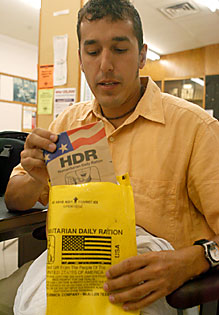 |
|
KEVIN KLAUS/Arizona Daily Wildcat
|
Joshua Trujillo yesterday displays a pouch of freeze-dried food that the U.S. military air-dropped to the Afghan people during the conflict.
|
|
By Kaila Wyman
Arizona Daily Wildcat
Thursday October 3, 2002
While working as a photographer at the Arizona Daily Wildcat just two years ago, Joshua Trujillo was put on assignment to cover the Fourth Avenue riots.
Having to watch for rubber pellets shot by the police and Tucsonans rioting was part of his job.
Compared to his job now, that was nothing.
A few months after graduating, Trujillo went to shoot photos in Afghanistan.
"I was shocked that they would send someone so green and fresh out of school," said Trujillo, now a photographer for Hearst Newspapers.
He was working for the Seattle Post-Intelligencer, when his editor sent him to Afghanistan for 10 weeks.
His job was to photograph the people of the rural areas affected by the war so newspapers could funnel images to their readers.
He had attributes that made him the person for the job.
He had four years of military experience and his dark skin color and ability to grow a thick beard allowed him to blend in among the people, he said.
When locals would come up and speak to him, he would pretend to be mute, letting his interpreter translate for him.
Trujillo said he was focusing more on feature photographs and tried to avoid the warfront.
"I tried to stay away from that stuff to give a little insight to the people and not so much to the front lines," Trujillo said. "Your instincts waver between getting powerful pictures and trying to stay alive."
The rural areas where he spent most of his time were not developed. Many locals had no electricity or running water.
People were suffering from lack of food and medicine, Trujillo said.
"What's even more frightening is the loss of the will to survive that you see in people," he said.
Trujillo lost 17 pounds in his 10 weeks.
He took food with him, but ran out quickly. He tried to live off the local food, but said it didn't settle well with his stomach.
He eventually began to eat the food packages that the United States had dropped for the Afghans.
Trujillo built relationships with some locals while he was there, including a young girl named Vida.
Vida's mother is a women's rights activist for Afghan women and wanted her daughter to be well-educated.
Vida was learning English at the time, and ended up building a friendship with a fourth grade class in New Mexico.
Trujillo's girlfriend taught the class. The class e-mailed back and forth with Vida using Trujillo's computer.
Some of the children were hesitant to correspond with Vida based on where she is from because the students only really knew that "the people in Afghanistan wrecked our twin towers," Trujillo said.
"One kid said, ╬What if they get our e-mail and come kill us,' " Trujillo added.
But this was before they spoke with Vida and then they realized that she was just like them. They learned that, just like them, she loves candy and playing with her friends.
With the background and knowledge of Afghanistan that Trujillo now has, he has become part of the news being interviewed and photographed.
"It's bizarre. I hate it," Trujillo said. "I photograph people being people, and, at the same time, what I hate most is my picture being taken."
Journalism Associate Professor Bill Greer worked closely with Trujillo during his time at the UA and when Trujillo called him and told him he was going to Afghanistan, Greer was happy to see Trujillo getting the opportunity. At the same time, Greer was also scared that something might happen to his former student.
"When the journalists got killed over there I just went wild until I found out that it wasn't him," Greer said.
"I always knew that he would end up one of the finest photojournalists in the United States, maybe in the world," Greer said. "He was great when he got here and he was great when he left."
Trujillo said that since he has returned, many doors have opened to him. And while he is currently working with a newspaper in San Antonio, he doesn't know where his career will take him.
"It's hard to go from a huge peak at the start of your career to the daily regular grind," he said.
Trujillo's photo exhibit "Assignment Afghanistan: A Visual Journey" will be on display on the second floor of the Main Library starting Monday through Nov. 22.
The photo exhibit will also be on display in the courtyard of the Integrated Learning Center at noon today.

